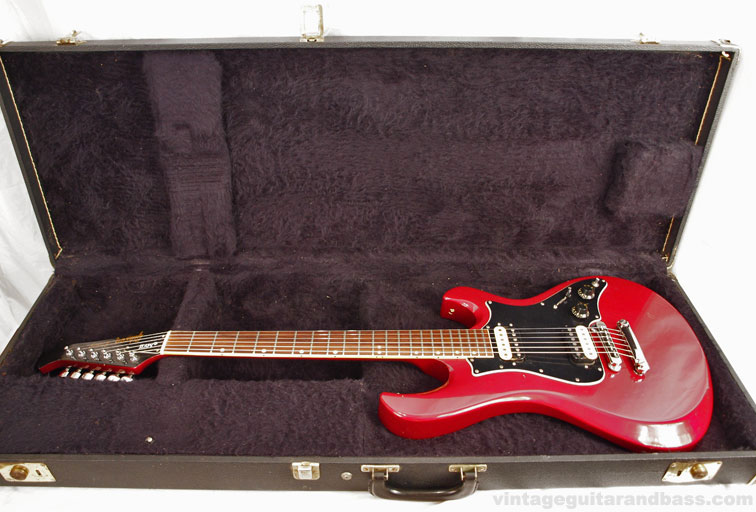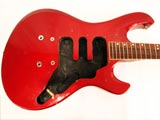This page has extra content in the
Supporting Members area, including additional images, video content, circuit diagram and scratchplate tracing. If you are a supporting member you can access this
here
Model: 1981 Gibson Victory MVII
Pickups: Two Tim Shaw-designed humbuckers, a
Velvet Brick at the neck, and a
Magna II at the bridge.
Scale: 24 3/4"
Body: Eastern hard rock maple. Length 18 15/16", width 13", depth 1 3/4".
Neck: Glued in three-ply Eastern hard rock maple neck with Indian rosewood fingerboard. Offset pearl dot inlays. White binding. 22 frets. 14 degree peghead pitch. MV-2 truss rod cover. Width at nut 1 11/16".
Hardware: 1 volume and 1 tone control, coil tap switch and three-way pickup selector switch.
Weight: 4.18kg
The Victory MVII (or MV2), MVX and Victory bass series were all designed to compete directly with a number of very well established Fender guitars; the body styles bore no resemblance to previous Gibson models, though they did have some of the high-end construction features that had made Gibson famous. The MVII, with it's single coil and humbucking modes was an overt challenge to the Fender Telecaster - supposedly doing everything the Fender can do, and more. It kept Gibson's traditional set neck, but the body styling and highly intuitive controls were pure Fender. It was solid maple, body and neck, so not a light guitar (this one weighs in at 4.18 kg), but substantial, durable, and with significantly more bite than perhaps one would expect from a Gibson.
This example was stamped at the Kalamazoo Michigan plant on the 3rd August 1981 (day 215), and would have been priced at $799 (1/1/1982 price list) - the same as the SG Standard. This is an early example, the majority of Victory MV guitars were built throughout the second half of 1981. Victory MV production also started at the Nashville plant, with a period of at least two months (Oct/November 1981) in which both plants were making them simultaneously. As 1982 dawned, the Kalamazoo plant stopped building the Victory, leaving the final instruments to Nashville for completion.
The following description comes from the 1981 Gibson Victory MV pre-owners manual - the references to country music were Gibson's way of saying 'this is our competitor to the Telecaster'.
“ The Victory MV 2 is designed primarily for the discerning country player. The MV 2 produces with unerring accuracy, those electric guitar voices, that make up the very essence of country music. From "down home" to sophisticated crossover "pop" country, the Victory MV2 is your guitar ”
Candy Apple Red was by far the most common finish seen on this model, although Antique Fireburst was also offered.
The MV2 was only included in price lists between January 1982 and January 1984, with no change in price throughout this period; see the Victory MV pricing and publicity.
The Victory MV2 and MVX shared the same body/neck; both are routed for three pickups, although obviously just two are fitted to the MV2. The routed area is painted matt black after the main red finish was applied. One difference between the two models is the fretboard material - beautifully grained Indian rosewood for the MV2 and Madagascan Ebony for the MVX.
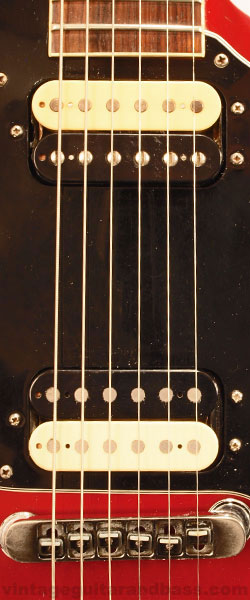
Each of the five pickups fitted to the MV2 and MV10 guitars was different; the MV2 had a
Velvet Brick humbucker at the neck, and a
Magna II at the bridge, both with contrasting black/cream (zebra) coil formers. The most obvious difference between these pickups (when examined
in situ is the lack of adjustable polepieces on the Magna II).

All hardware is chrome plated. The Victory MV guitars were the first to be fitted with Gibson's new design
top adjust tune-o-matic bridge (part 80087) - shown here with nylon saddles - but used the original
stop tailpiece assembly (part 81509) paired with other Tune-O-Matic bridges since the 1950s.
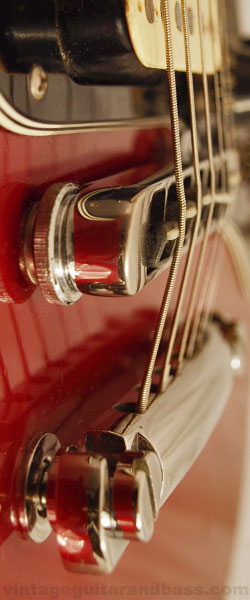
The bridge bar is not flat, it slants backwards, as seen in this side view, "to allow full clearance of the strings to the stop bar tailpiece, so the player can lower the tailpiece all the way to the wood". AS explained in the
Victory MV owners manual, raising and lowering the tailpiece directly affects response, sustain, and the firmness of action.
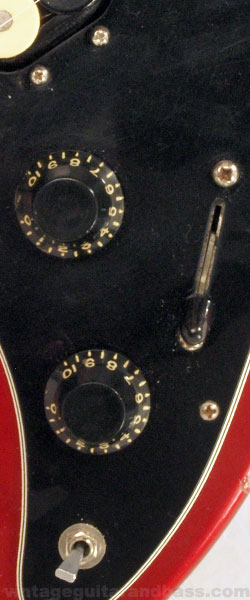
The Victory MV guitars were some of the earliest models to use the black 0-10 "top hat" control knobs. As to be expected, the two knobs are the volume and tone controls, whilst the three-way blade switch is a standard 'front', 'back' or 'both' pickup selector. The mini-toggle switch sets the pickups to humbucking mode (up) and single coil (down).
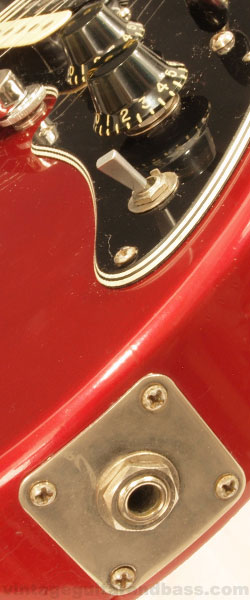
The input jack is on the bottom edge of the of the guitar's body. The laminations of the five-ply scratchplate are clearly visible in this image.
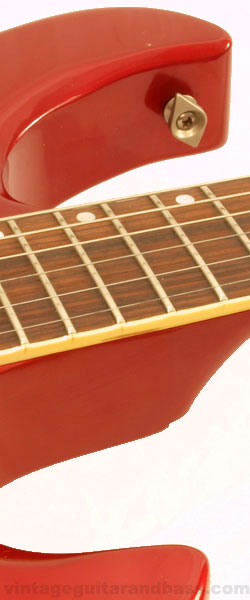
The Victory series guitars were fitted with diamond-shaped Posilok strap buttons.
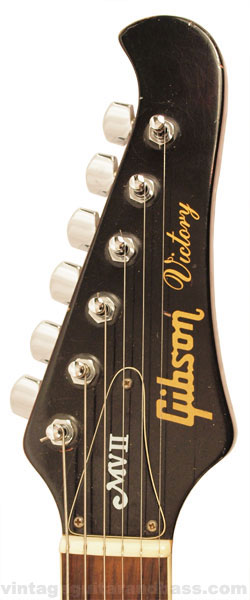
The
Firebird-styled headstock was the only nod to 'traditional' Gibson styling. The gold Gibson logo is silk-screened, whilst the MVII model designation is applied in white onto the truss rod cover. MV, or course, stands for Multi-Voice. This cover also steps away from Gibson tradition - not bell-shaped, but an irregularly curved triangle held in place with three screws.
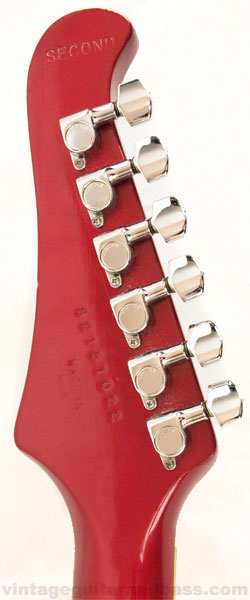
The back of the headstock holds the serial number and 'MADE IN USA' designation. The serial number 82151022 tells us that this guitar was stamped on August 3rd, 1981 (day 215), and was the 22nd instrument stamped that day at Gibson's Kalamazoo plant.

Reverse headstock view with tuning keys and SECOND stamp. A 'second' was a guitar with a minor flaw, often in the finish, that would have been sold at a lower price, often to Gibson employees. After a few years of use, such defects are typically undetectable.
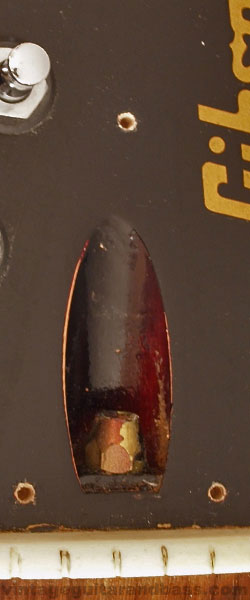
The truss rod has a standard Gibson 5/16" adjustment nut, accessible by removing the truss rod cover.

The MVII was fitted with a bound Indian rosewood fretboard; in contrast to the MVX with it's board of Madagascan ebony. Both had the distinctive off-centre pearl dot markers, with a double dot at the twelfth fret.
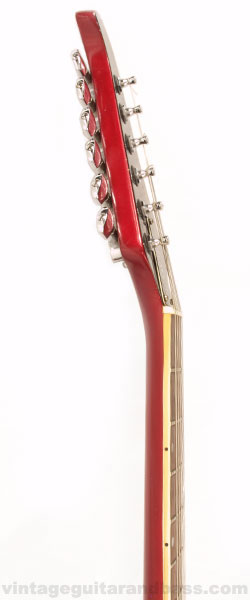
14 degree peghead pitch. Note that there is no volute on this neck.
Both the Victory MV2 and MV10 used a black-lined Gibson case, number 8170.
1981 Gibson Victory MV2 'supporting members' content
Extra content on this guitar is included in our Supporting Members area here.
- 20 extra images (with description): large detailed images including body routes, circuitry, components
- Pickguard tracing (PDF for accurate printing)
Got an opinion on the contents of this page? Disagree with something written above? Please
comment















